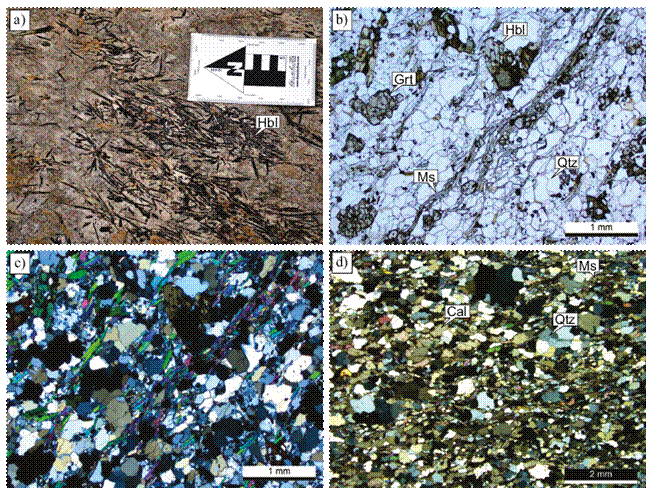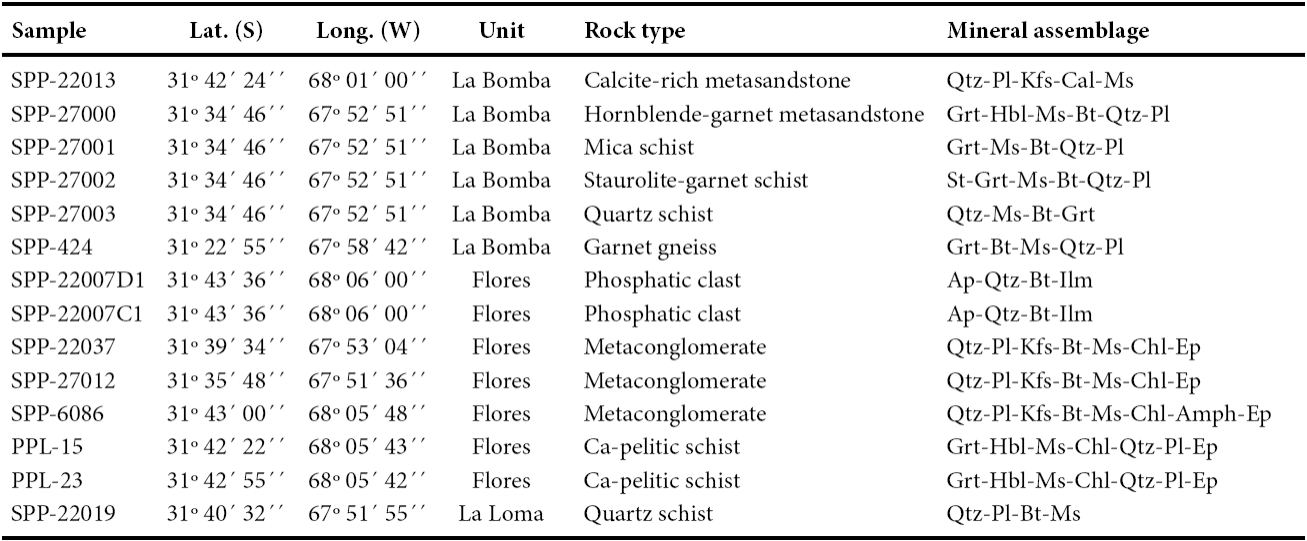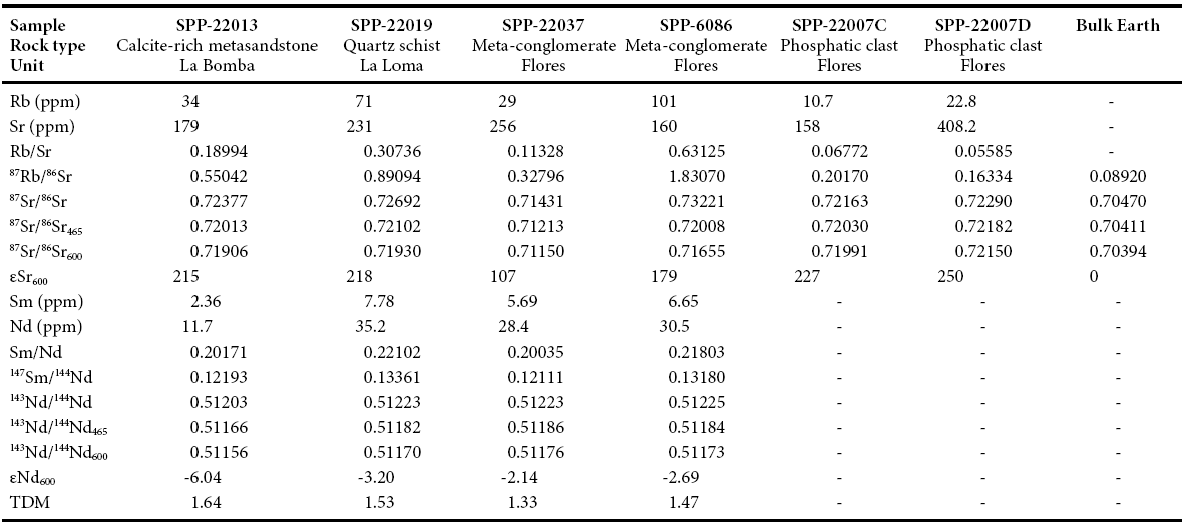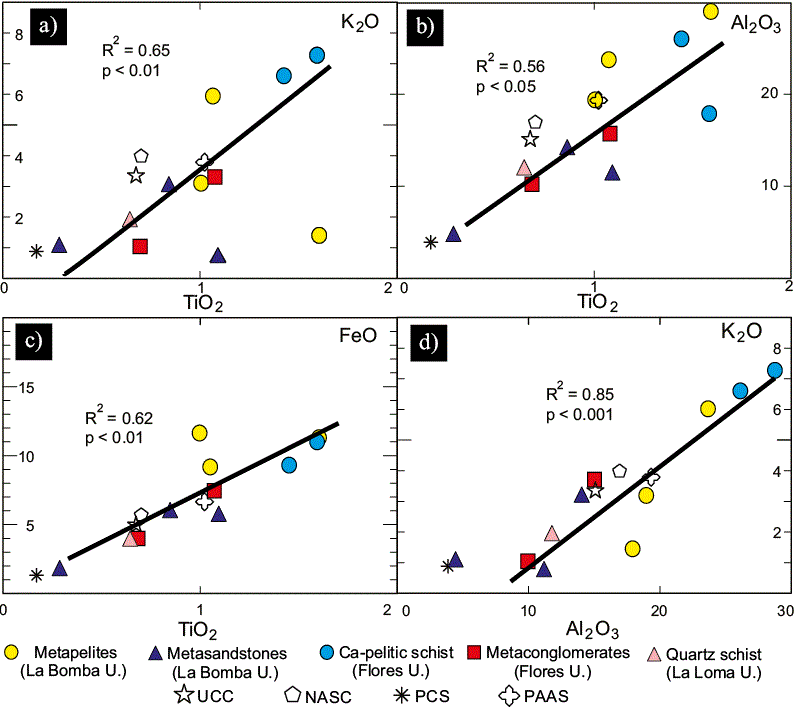INTRODUCTION
The Sierra de Pie de Palo (SPP) is one of the Western Sierras Pampeanas (WSP) of Argentina which resulted from Cenozoic uplift in response to shortening of the Andean foreland (Jordan and Allmendiger, 1986; Isacks, 1988). The WSP mainly consists of middle to late Mesoproterozoic basement and a late Neoproterozoic (Ediacaran) sedimentary cover (McDonough et al., 1993; Casquet et al., 2001; Galindo et al., 2004; Rapela et al., 2005). Basement and cover were overprinted by metamorphism and penetrative deformation during the widespread early to middle Ordovician accretionary Famatinian orogeny (Casquet et al., 2001; Mulcahy et al., 2011; van Staal et al., 2011). The metasedimentary succession was recognized and named by Baldo et al. (1998) as the Difunta Correa metasedimentary sequence (DCMS) and represents a poorly known Neoproterozoic basin. Likely, the DCMS also crops out in other ranges of the WSP, namely Maz, Espinal and Umango (Figure 1a) where a mesoproterozoic basement has also been recognized (Casquet et al., 2008; Varela et al., 2011). However, the original relationships between the basement and the metasedimentary cover are always oscured by shearing and faulting.
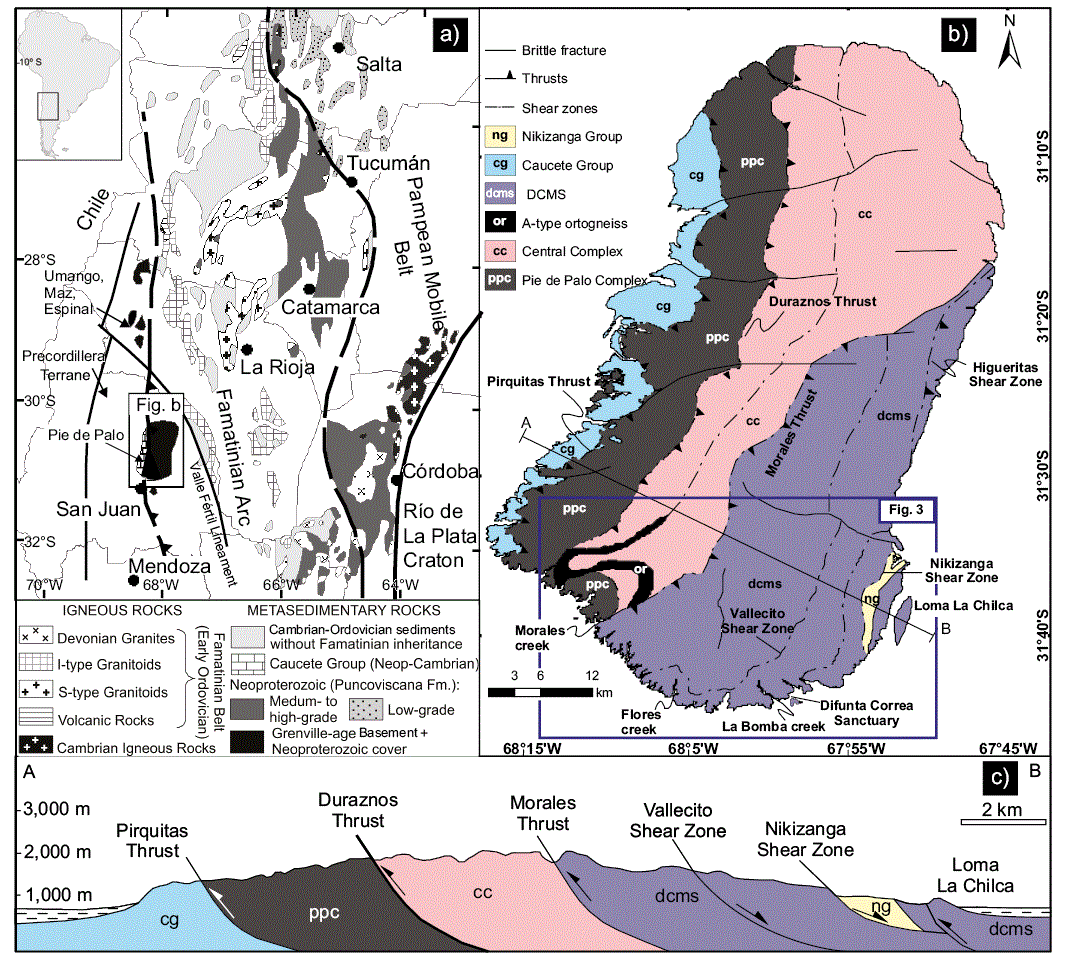
Figure 1 a) Geological setting of the Sierras Pampeanas showing the location of the Sierra de Pie de Palo (SPP); b) Geological map of the SPP; c) Schematic east cross-section of the SPP showing the main geological units and structural boundaries. DCMS: Difunta Correa metasedimentary sequence.
The DCMS constitutes a key entity to the paleogeography of the WSP during the late Neoproterozoic, before its accretion to southwestern Gondwana in the early Cambrian (Casquet et al., 2012; Rapela et al., 2015). These authors suggest that the WSP Mesoproterozoic basement developed after the MARA Paleoproterozoic craton (MARA, acronym of Maz, Arequipa, Río Apa). This craton was accreted to Laurentia -and consequently reworkedin the middle to late Mesoproterozoic orogenies between ca. 1.3 and 1.0 Ga. MARA drifted away from Laurentia in the late Neoproterozoic, resulting in the opening of the Iapetus Ocean. This basement was further involved in the early Cambrian Pampean orogeny of the Eastern Sierras Pampeanas by collision with other southwestern Gondwana cratons (such as Kalahari). This collision resulted in the closure of the hypothetical Clymene Ocean (Trindade et al., 2006), and its southeastern extension (present position), i.e., Puncoviscana Ocean.
Conventional petrological provenance studies of detrital rocks (sandstones; Dickinson and Suczek, 1979; Zuffa, 1985; Jonhsson, 1993; Arribas et al., 2007) are hindered if the rocks underwent significant metamorphism and deformation. Primary components of the sedimentary rocks are deeply modified by processes such as recrystallization, formation of new minerals and development of a new tectonic fabric (foliation). In such cases, methods based on the chemical composition of the metasedimentary rocks help to define the source areas and to establish the tectonic setting of sedimentary basins (Bhatia and Crook, 1986; McLennan et al., 1990, 2003; Zimmermann et al., 2011). However, chemical data alone can lead to erroneous interpretation of the tectonic setting, especially in ancient basins (Armstrong-Altrin and Verma, 2005; Verdecchia and Baldo, 2010). Therefore, they are supported here by complementary evidence from regional geological knowledge and detrital zircon data (Rapela et al., 2015).
Some major and trace elements (e.g., Si, Al, Fe, Mg, Mn, Ca, K, Ba, Sr, Rb and Cs) can be removed from sediments during weathering, diagenesis and lowto mediumgrade metamorphism, and therefore they are not appropriate for constraining source areas and/or tectonic settings. On the other hand, elements such as Ti, La, Ce, Nd, Y, Th, Zr, Hf, Nb, and Sc within resistant detrital minerals preserve the initial inter-elemental ratios, and, in consequence, they are useful for provenance analyses (Bhatia and Crook, 1986; Floyd and Leveridge, 1987; McLennan, 1989; McLennan et al., 1990; Zimmermann and Bahlburg, 2003).
The aim of this research is to infer source areas and the tectonic setting of the DCMS through regional, chemical, and isotope evidences of significant rock types, and to discuss the paleogeographic implications. Moreover, we present here the first mention of phosphatic clasts in the Sierras Pampeanas and evaluate their paleoclimatic and paleogeographic significance.
GEOLOGICAL SETTING
The SPP consists of five lithological assemblages bounded by east-dipping shear zones and thrusts. From west to the east they are: the Caucete Group, the Pie de Palo Complex, the Central Complex, the DCMS, and the Nikizanga Group (Figure 1). All these units are overprinted by metamorphism and intruded by igneous rocks, both assigned to the Ordovician Famatinian orogeny (Pankhurst and Rapela, 1998; Casquet et al., 2001; Mulcahy et al., 2011; Baldo et al., 2012).
The Caucete Group (Borrello, 1969; Vujovich, 2003; Galindo et al., 2004; Naipauer et al., 2010; van Staal et al., 2011) is exposed along the western margin of the SPP, in the footwall of the major Pirquitas thrust (Figure 1b), and mainly consists of lowto medium-grade metamorphic rocks such as metasandstones and marbles, and to a lesser extent, metavolcaniclastic rocks. A late Neoproterozoic-early Cambrian depositional age was established for this group based on Sr-isotope composition of marbles (Galindo et al., 2004) and U-Pb zircon ages from metasandstones (Naipauer et al., 2010).
The Pie de Palo Complex (sensu Mulcahy et al., 2011) lies between the Pirquitas and the Duraznos thrusts (Figure 1b and 1c) and is mainly composed of ultramafic and mafic rocks, largely metagabbros and garnet-amphibolites. Mesoproterozoic (ca. 1,067-1,204 Ma) U-Pb zircon crystallization ages were obtained for this complex (Vujovich et al., 2004; Morata et al., 2010; Rapela et al., 2010; Mulcahy et al., 2011). The Pie de Palo Complex is an igneous sequence formed in a back-arc setting (Vujovich and Kay, 1998).
The Caucete Group and the Pie de Palo Complex have been correlated with the cover and the basement, respectively, of the worldwide known Precordillera terrane. This correlation was based on Sr-isotope composition of marbles (Galindo et al., 2004) and detrital zircon ages (Naipauer et al., 2010) of Caucete Group, and on common Pb composition and geochronology of the ultramafic and mafic rocks of the Pie de Palo Complex (Abbruzzi et al., 1993; Kay et al., 1996). Many authors consider that the Precordillera is an exotic terrane of Laurentian affinity that accreted to the proto-Andean margin during the Famatinian orogeny (Thomas and Astini, 2003; Ramos, 2004).
The Central Complex is defined here as a large block between the Duraznos and the Morales thrusts. The latter ductile thrust was recognized in the Morales creek (Figure 1b) and we were able to track it northward using satellite images. The boundary between the Central Complex and the DCMS is poorly known due to access difficulties. The Central Complex consists of schists, quartzites, marbles, migmatites, amphibolites, metavolcanic rocks and orthogneisses (Casquet et al., 2001; Mulcahy et al., 2011). One orthogneis is an A-type granitoid of ca. 774 Ma attributed to the break-up of Rodinia (Baldo et al., 2006). Other orthogneisses range from ca. 1,280 to ca. 1,027 Ma (McDonough et al., 1993; Rapela et al., 2010; Garber et al., 2014), and therefore, the depositional age of the metasedimentary rocks of this complex has to be older than those of the igneous intrusions. In consequence, the Central Complex probably constitutes a mesoproterozoic basement.
The DCMS was described by Baldo et al. (1998) as a sequence made up of metapelites, Ca-pelitic schists, quartzites, quartz-feldspar metasandstones, marbles and para-amphibolites. The DCMS is widespread along the central and eastern parts of the SPP. A late Neoproterozoic depositional age for the DCMS was proposed by Galindo et al. (2004) on the basis that the Sr-isotope composition of the calcite marbles corresponds to sea-water composition at that time. The age of, at least, the lower and the middle part of the DCMS probably is ca. 600 Ma according to the more recent sea-water compilations and U-Pb detrital zircon ages (Rapela et al., 2005, 2015; Murra et al., 2014). We recognize four units in the DCMS; from bottom to top: La Loma, Flores, Vallecito, and La Bomba (Figure 2).
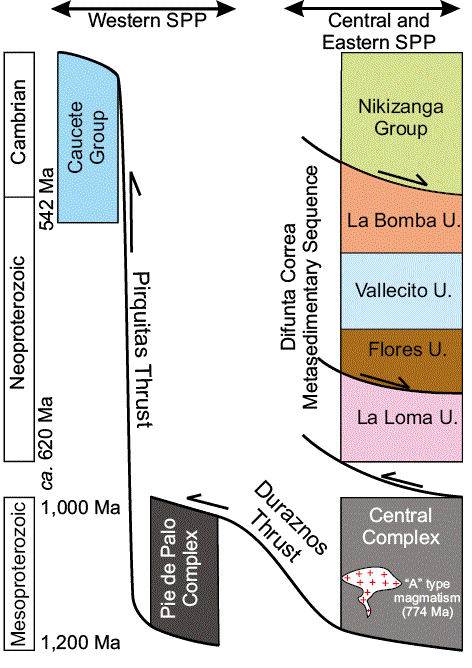
Figure 2 Main units of the Sierra de Pie de Palo (SPP) and structural relationships. Thicknesses are not to scale.
The Nikizanga Group crops out in the southeastern portion of the SPP and consists of lowto mediumgrade metamorphic rocks (quartzites, marbles, graphitic schists and, to a lesser extent, amphibolites; Figure 1b). An early Cambrian depositional age was obtained for this group based on Sr-isotope composition of marbles (Filo del Grafito marbles; Galindo et al., 2004), which was latter supported by U-Pb detrital zircon ages from a quartzite (Ramacciotti et al., 2014).
FIELD AND PETROGRAPHIC DESCRIPTIONS
The DCMS was affected by numerous shear zones, thrusts and brittle Andean faults that complicate the overall picture (Figure 3). Sedimentary structures and textures of the DCMS were largely obliterated and replaced by metamorphic textures as a consequence of strong deformation, recrystallization, and formation of new minerals during the Ordovician Famatinian metamorphism (Casquet et al., 2001). Only the metaconglomerates preserve some primary structures (e.g., graded-bedding and cross-bedding) and relict minerals in weakly deformed areas. Thus, the classification of protoliths was mainly based on geochemical data and not on mineral modes. The metasedimentary units are described below, from bottom to top (Figure 4):
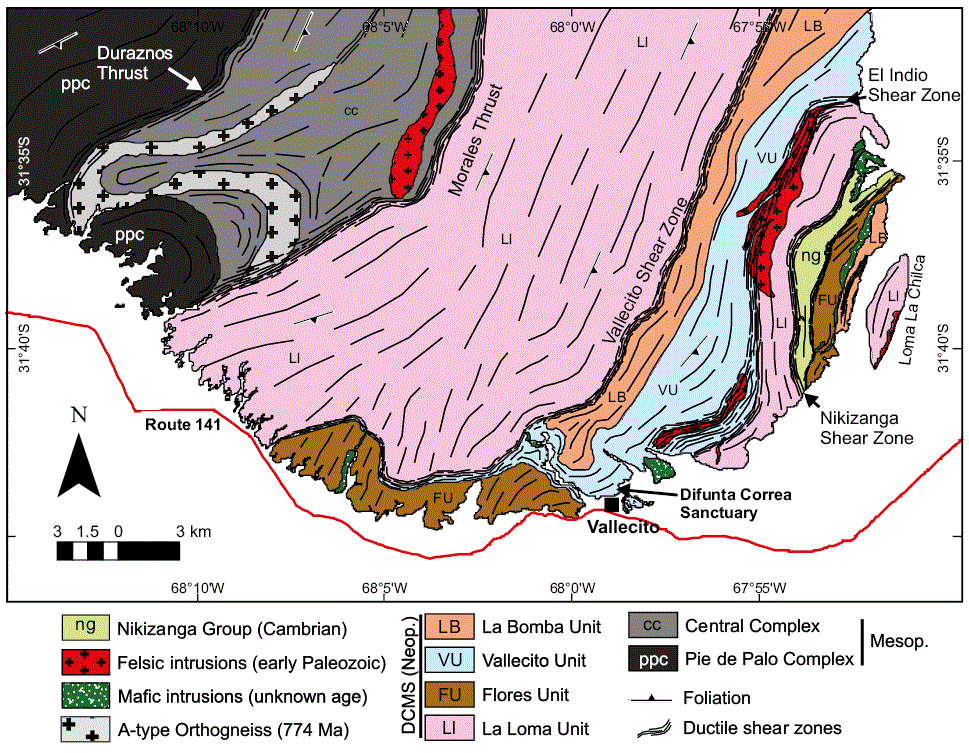
Figure 3 Geological map of the southern SPP showing the four units of the Difunta Correa metasedimentary sequence (DCMS).
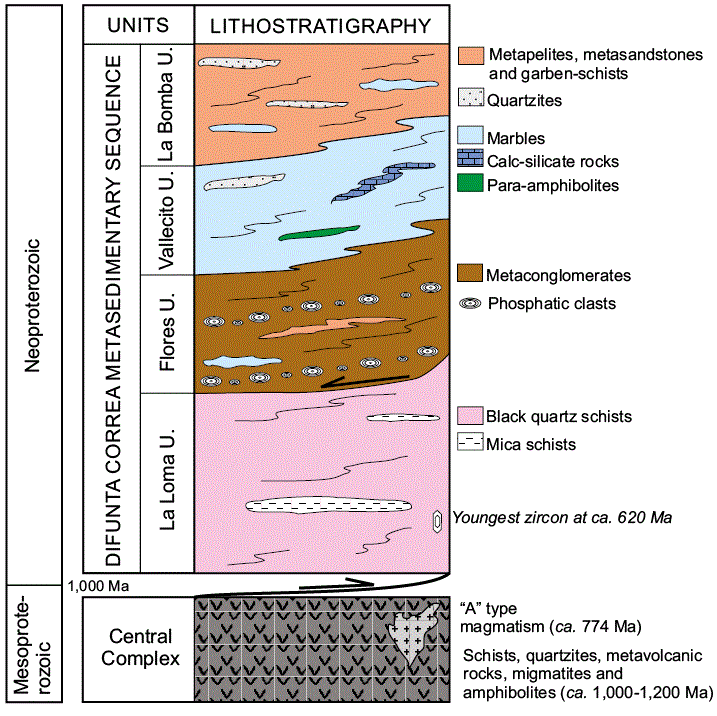
Figure 4 Schematic lithostratigraphic column of the Difunta Correa metasedimentary sequence. The youngest zircon age is from Rapela et al. (2005, 2015).
La Loma unit consists almost exclusively of black quartz schists and widely outcrops in southeastern SPP (Figure 3). Schists are massive or banded and show a NE-SW striking, east-dipping, penetrative tectonic foliation (Figure 5a). They were affected by numerous shear zones, and often show chevron folds (Figure 5b). The mineral assemblage mainly consists of quartz, with minor amounts of biotite, muscovite, plagioclase and zircon, with a fine-grained (< 1 mm) granoblastic texture (Figure 5c).
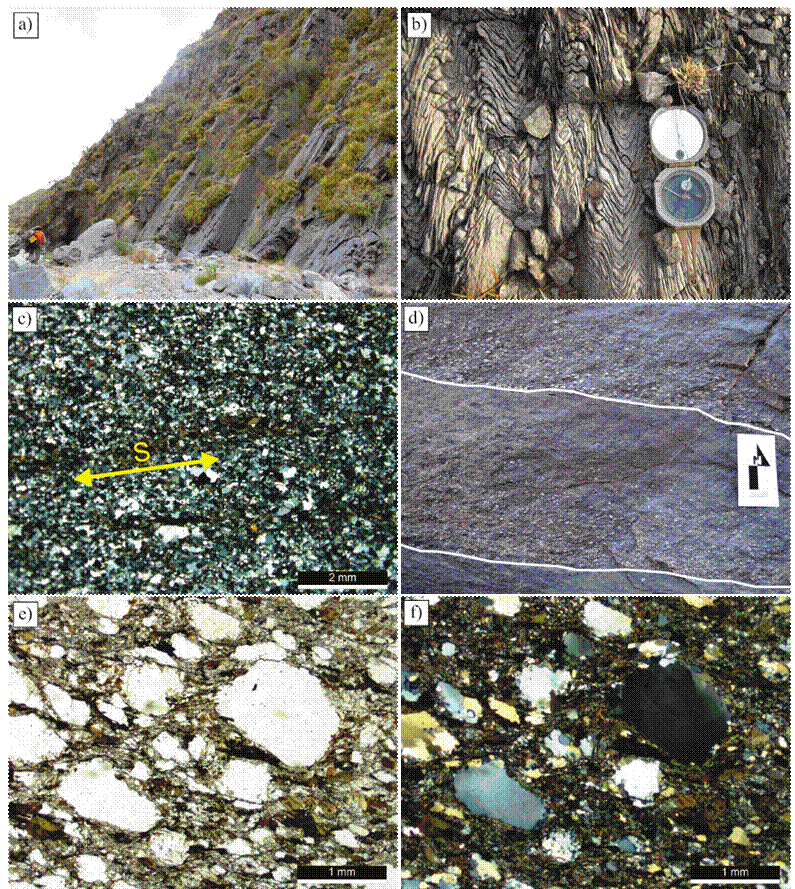
Figure 5 Field and petrographic characteristics of La Loma unit (a-c) and the Flores unit (d-f). a) Evenly foliated, black, quartz schists; b) Banded and folded (chevron folds) quartz schists; c) Fine-grained granoblastic texture mainly composed of quartz and, to a lesser extent, of oriented micas which define the foliation of the rock; d) Normal graded bedding in metaconglomerates; e) and f) PPL and crossed polars photomicrograph of metaconglomerates showing relict minerals (clasts) and recrystallized matrix.
The Flores unit consists mainly of metaconglomerates, and less abundant Ca-pelitic schists. The former are matrix-supported with monocrystalline clasts of quartz and feldspar (2-15 mm), and locally, large (5-20 cm) phosphatic clasts which are described below. The metaconglomerates are lens-shaped and often grade in short distances into arenites (Figure 5d). The metamorphic mineral assemblage of the matrix is Qtz-Pl-Bt-Ms±Grt-Ep-Amph-Zrn-Ap-Op (abreviations after Kretz, 1983; Figure 5e and 5f). Phosphatic clasts within the metaconglomerates are between 2 and 20 cm long and were flattened parallel to the main foliation. They consist of Ap-Qtz-Bt-Ilm (identified by electron microprobe) with microgranular texture (Figure 6a and 6b). Internally, the clasts show an alternation of phosphate-rich rock and thin, curved, quartz-rich veinlets (white arrows in Figure 6b). Sometimes an outer zone is found between the phosphatic clasts and the host conglomerate, containing abundant disseminated apatite, probably due to the exchange reaction during metamorphism (zone I in Figure 6a; see Discussion section). The mineral mode of phosphate rock was estimated using the software imageJ (Abràmoff et al., 2004). Sample SPP-22007D1 yielded: 45.5 % Ap, 41.6 % Qtz, 10.2 % Bt, 2.7 % Ilm (Figure 7). Ca-pelitic schists consist of Ms-Hbl-Grt-Bt-Ep-Chl-Pl±Zrn-Op. They are characterized by the presence of Ca-minerals (amphibole and/or epidote) in association with typical metapelite minerals (e.g., muscovite, biotite, garnet). Distinctive textural features consist of large, needle-shaped porphyroblasts of hornblende lying in the foliation plane with a radial arrangement (Figure 8a and 8b), and of garnet porphyroblasts discordant to the foliation (Figure 8b). Both textures suggest that minerals grew up late relative to foliation development. The textures and mineral composition of the DCMS Ca-pelitic schists are remarkably similar to garben-schists or garbenschiefer in the eastern Alps (Selverstone et al., 1984).
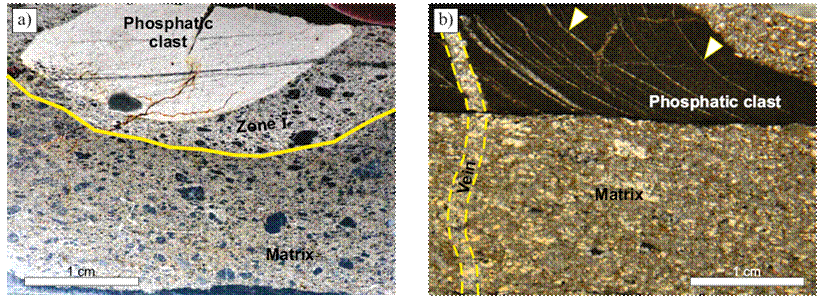
Figure 6 Phosphatic clasts within metaconglomerates of the Flores unit. a) Thin section of one phosphatic clast showing an outer zone of apatite-enriched host conglomerate (zone I); b) Crossed polars photomicrograph of a phosphatic clast with a truncated alternation of phosphate-rich rocks and thin veinlets of quartz (white arrow) and a cross-cutting quartz vein.
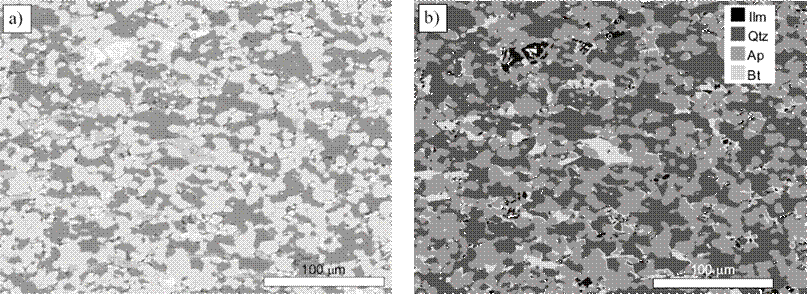
Figure 7 a) Secondary electron (SEM) image showing the slightly orientated microgranular texture of a phosphatic clast core (SPP-22007D1). The black areas are holes which were not considered for modal analysis, and are merged with quartz in b); b) Image a) processed with ImageJ software.
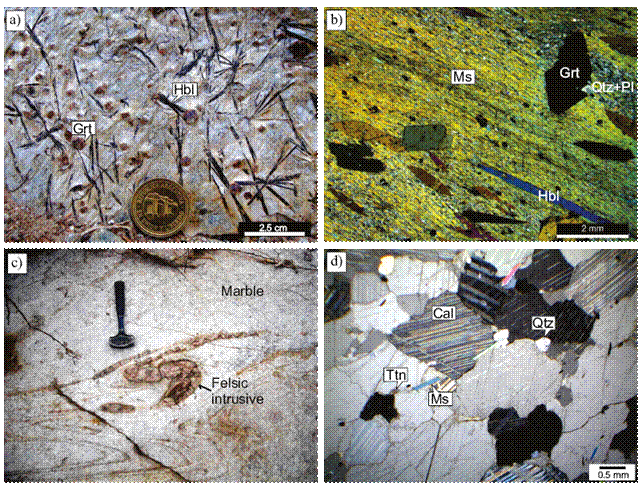
Figure 8 a) and b) Ca-pelitic schists (garben-schists) from the Flores unit. c) and d) Marbles from the Vallecito unit. c) Deformed marble with folded felsic intrusive, d) Crossed polars photomicrograph of marbles showing a granoblastic texture.
The Vallecito unit, with a maximum apparent thickness of 3000 m, is mainly composed of calcite-rich marbles interbedded with calcsilicate rocks and quartzites. An abundant type of calc-silicate rock is para-amphibolite, i.e., amphibolite formed after a sedimentary protolith (Rapela et al., 2005). Marbles are often intruded by Ordovician granitoids (Baldo et al., 2012) (Figure 8c) and exhibit a granoblastic texture with the minerals Cal±Dol-Ms-Bt-Chl-Pl-Qtz-Ttn-Zrn-Ap (Figure 8d).
La Bomba unit is composed of a succession of metapelites and metasandstones of variable composition (Figure 9a). The main rock types are: staurolite-garnet schists, garnet schists, hornblende-garnet metasandstones and calcite-rich metasandstones. The staurolite-garnet schists have a mineral assemblage of St-Grt-Bt-Ms-Pl-Qtz±Ap-Zrn and are characterized by the abundance of staurolite and garnet porphyroblasts set in a foliated mica-rich matrix (Figure 9b and c). The garnet schists consist of Ms-Grt-Bt-Qtz-Pl also with garnet as porphyroblasts and a lepidoblastic to granoblastic matrix (Figure 9d). The hornblende-garnet metasandstones bear many similarities to Capelitic schists (garben-schists) of the Flores unit, whit the exception that they are more psammitic (Figure 10a-10c; compare with Figure 8a). The calcite-rich metasandstones are mainly composed of quartz and calcite, whit minor amounts of muscovite, and show a granoblastic texture (Figure 10d).
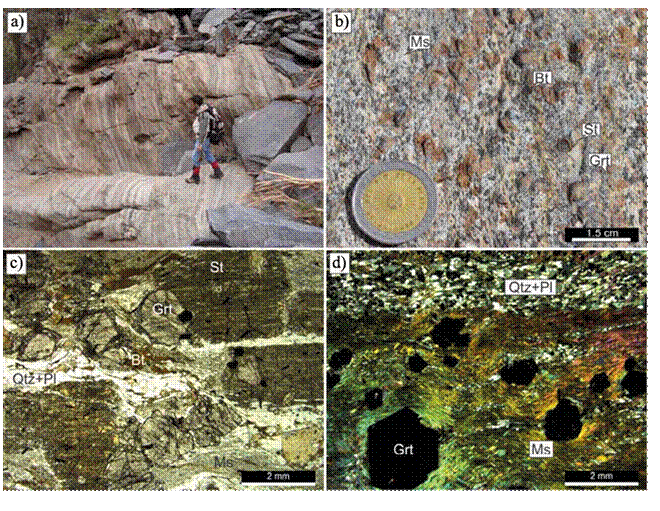
Figure 9 La Bomba unit. a) Succession of metapelites and metasandstones; b) Staurolite-garnet schist; c) PPL photomicrograph of a staurolite-garnet schist; d) Crossed polars photomicrograph of a garnet schist.
SAMPLING AND ANALYTICAL METHODS
Representative samples from the three meta-detrital units that form the DCMS were chosen for chemical and isotope analyses. Details of each sample are given in Table 1.
Chemical analyses were carried out on eleven samples (Table 2). Six samples were analyzed at Activation Laboratories Ltd. (Actlabs, Ontario, Canada) following the 4 Litho-research routine. Major elements were determinate by ICP-AES, whereas minor and trace elements were determinate by ICP-MS. The remaining five samples were analyzed by X-ray fluorescence (XRF) at the Laboratorio of the Instituto de Geología y Minería, Universidad Nacional de Jujuy, Argentina on a Rigaku FX2000 spectrometer with Rh tube (Table 2). Ground and homogenized samples were fused with lithium tetraborate for major element analyses. Trace element determinations were performed on rock powder pellets mixed with methyl methacrylate, and pressed at 20 t. Operating conditions were 50 kV and 45 mA.
Table 2 Chemical analyses. *Samples analyzed at Actlabs. The remaining samples were analyzed at the Laboratory of the Instituto de Geología y Minería, Universidad Nacional de Jujuy, Argentina. Total Fe content is expressed as Fe2O3.
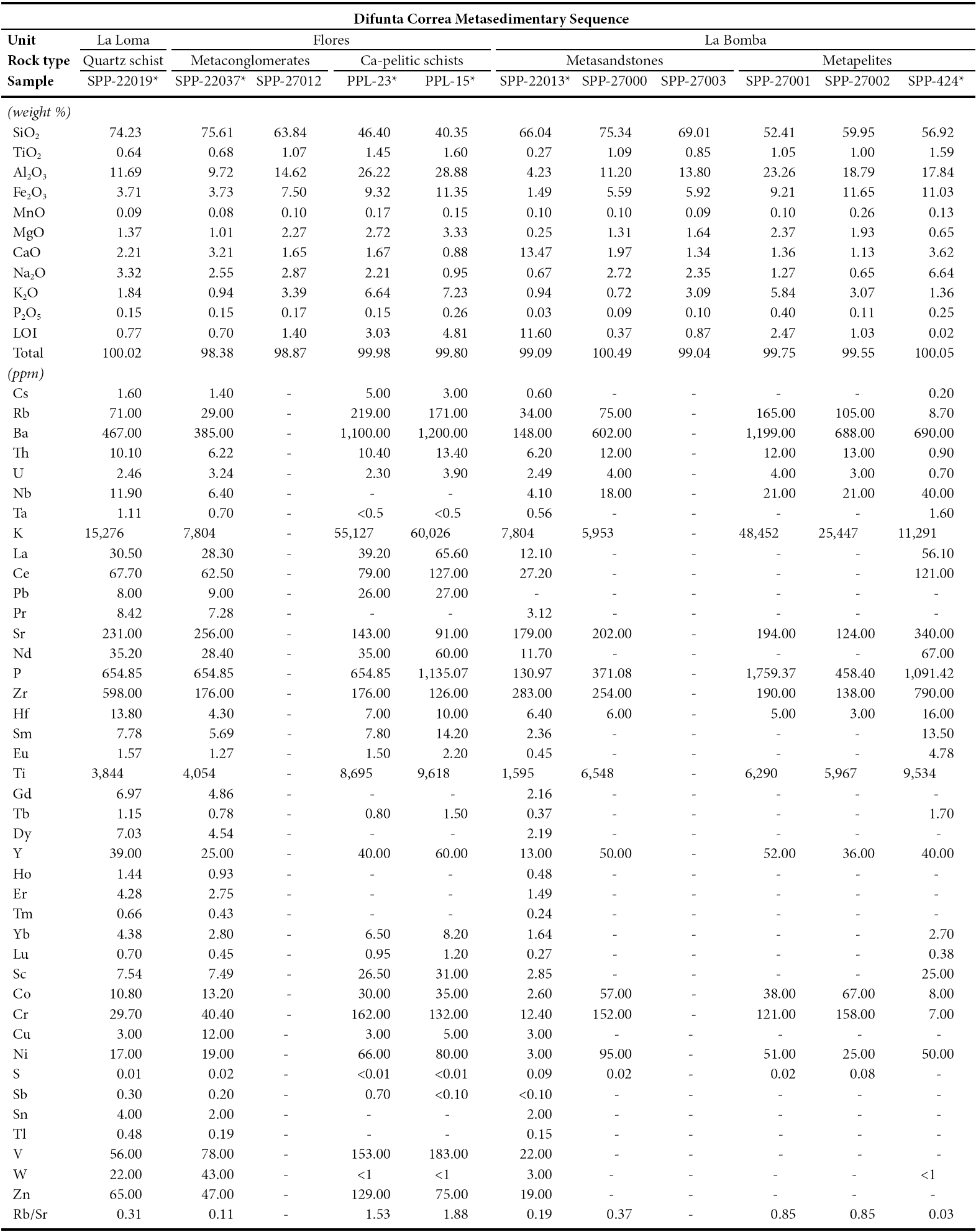
Rb-Sr and Sm-Nd isotope analyses were carried out on four detrital rocks. Additionally, Rb-Sr isotope data was collected from two phosphatic clasts within the metaconglomerates of the Flores unit (Table 3). Analytical work was carried out at the Centro de Geocronología y Geoquímica de Isótopos of the Universidad Complutense de Madrid on a PHOENIX(c) automated multicollector mass-spectrometer. Whole rocks (siliciclastic rocks) were first decomposed in 4 ml HF Mercksuprapure and 2 ml HNO3 Merck-suprapure in Teflon digestion bombs for 48 hours at 120 °C, and finally in 6M HCl. Concentrations of Rb and Sr, as well as Rb/Sr atomic ratios, were determined by X-ray fluorescence spectrometry at the X-Ray Centro de Difracción de la Universidad Complutense following the methods of Pankhurst and O`Nions (1973). Sr and REE were separated using Bio-Rad AG50 x 12 cation exchange resin. The phosphatic clasts were decomposed in 6M HCl in Nalgene beakers and, after evaporation, dissolved with 3M HNO3; Sr was separated using an extraction chromatographic SrResinTM. Errors are quoted throughout as two standard deviations (2σ) from measured or calculated values. The decay constant used in the calculations is λ 87Rb = 1.42×10-11year-1 recommended by the IUGS Subcommision for Geochronology (Steiger and Jäger, 1977). Bulk Earth Sr-isotope composition was calculated from Allègre et al. (1983) and Taylor and McLennan (1985). Analytical uncertainties are estimated to be 0.01 % for 87Sr/86Sr and 1 % for 87Rb/86Sr ratios. Epsilon-Sr (εSr) values were calculated relative to a Bulk Earth present-day 87Sr/86Sr value of 0.7045 and 87Rb/86Sr of 0.0827 (DePaolo, 1988). Replicate analyses of the NBS-987 Sr-isotope standard yielded an average 87Sr/86Sr ratio of 0.710245 ± 0.00003 (n = 14), (accepted value: 0.71025 ± 0.00005; Faure, 2001)
Samarium and neodymium were determined by isotope dilution using spikes enriched in 149Sm and 150Nd and were separated from the REE group using Bio-beads coated with 10 % HDEHP. Errors are quoted throughout as two standard deviations (2 σ) from measured or calculated values. The decay constants used in the calculations are the values λ 147Sm = 6.54×10-12 year-1 recommended by the IUGS Subcommision for Geochronology (Steiger and Jäger, 1977). Analytical uncertainties are estimated to be 0.006 % for 143Nd/144 Nd ratios and 0.1 % for 147Sm/144 Nd ratios. Epsilon-Nd (εNd) values were calculated relative to a present-day chondrite 143Nd/144 Nd value of 0.512638 and 147Sm/144Nd of 0.1967 (Jacobsen and Wasserburg, 1980; Goldstein et al., 1984). Eight analyses of La Jolla Nd-standard measured during sample analysis gave a mean 143Nd/144Nd ratio of 0.511845 ± 0.00001 (accepted value: 0.511858 ± 0.00007; Lugmair and Carlson, 1978). Single stage model ages (TDM) was calculated according to DePaolo (1988).
The composition of phosphate minerals was determined in one phosphatic clast (SPP-22007D1; Table 4) using a JEOL JXA8230 Superprobe at the Universidad Nacional de Córdoba, Argentina. Carbon-coated polished sections were analyzed at 15 kV using 20 nA beam and a range of natural and synthetic standards.
RESULTS
Detrital rocks geochemistry
Geochemical data from the DCMS siliciclastic rocks are shown in Table 2. According to Herron ́s (1988) plot (Figure 11) the samples are classified as pelites (shales and Fe-Shale) and sandstones (wackes, sub-litharenites, litharenites and Fe-sandstones). The Ca-pelitic schist from the Flores unit shows the lowest concentration of SiO2 (40.3-46.4 %) and the highest contents of Al2O3 (26.2-28.9 %) and K2O (6.6-7.2 %). Metapelites from La Bomba unit (staurolite-garnet schists) show similar values compared to the Ca-pelitic schist, whereas quartz schists (La Loma U.), metaconglomerates (Flores U.) and metasandstones (La Bomba U.) exhibit higher concentrations of SiO2 (63.8-75.6 %) and the lowest contents of Al2O3 and K2O (4.2-14.6 % and 0.7-3.4 % respectively; Table 2).

Figure 11 Herron (1988) classification diagram of sedimentary rocks. UCC: Upper Continental Crust (McLennan, 2001); PAAS: Post-Archean Australian Shales (Taylor and McLennan, 1985); NASC: North American Shale Composite (Gromet et al., 1984); PCS: Proterozoic Cratonic Sandstones (Condie, 1993).
Geochemical variations among samples (Figure 12) reflect changes in their mineralogical composition. Modal variations of phyllosilicates (pelitic component) relative to quartz-feldspar (psammitic component) are supported by: 1) negative correlations of SiO2 against TiO2 (R2 = 0.66; p < 0.01), Al2O3 (R2 = 0.98; p < 0.001), Fe2O3 (R2 = 0.71; p = < 0.01), MgO (R2 = 0.58; p < 0.05), and K2O (R2 = 0.77; p < 0.001; Figure 12a-12e) and 2) positive correlations of TiO2 against Fe2O3 (R2 = 0.62; p < 0.01), Al2O3 (R2 = 0.56; p < 0.05), and K2O (R2 = 0.65; p < 0.01), and of Al2O3 with K2O (R2 = 0.85; p < 0.001; Figure 13). No clear patterns between CaO, Na2O, MnO and P2O5 are recognized probably because they are mobile elements (Figure 12f-12i).
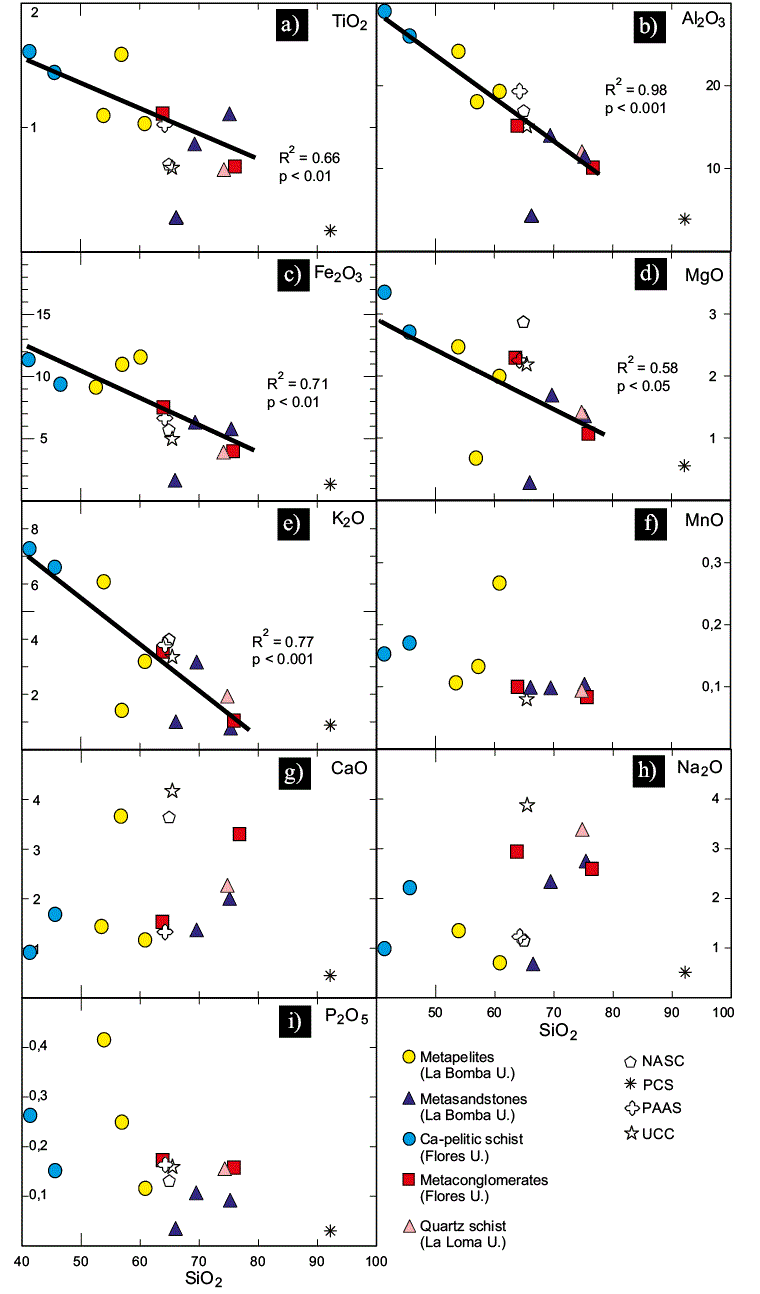
Figure 12 Chemical variation plots of metasedimentary rocks from the Difunta Correa metasedimentary sequence. Samples SPP-22013 and SPP-424 are not shown in the CaO and Na2O plots (respectively) because contents of these components are off-scale. Values in weight percent. Sample SPP-22013 was not considered in correlation coefficients due to their carbonaceous cement.
Relationships between major and trace elements are shown in Figure 14. The effect of the pelitic component is reflected by a positive correlation between K2O against Ba (R2 = 0.90; p < 0.001) and Rb (R2 = 0.92; p < 0.001) (Figure 14a and 14b). The highest concentrations of Zr and SiO2 are found in metasandstones (La Bomba U.), quartz schist (La Loma U.) and metaconglomerates (Flores U.).
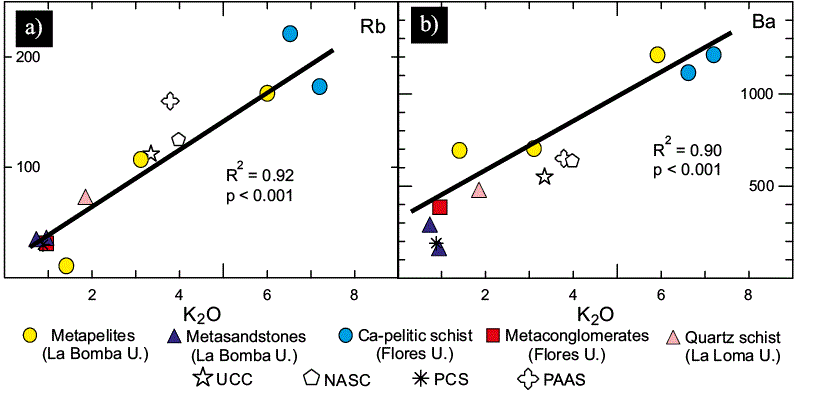
Figure 14 Variation plots of Rb and Ba of metasedimentary rocks from the Difunta Correa metasedimentary sequence. Values in weight percent for major elements and ppm for trace elements. Sample SPP-22013 was not considered in correlation coefficients due to their carbonaceous cement.
The REE concentration of metasedimentary rocks is strongly influenced by the grain size and mineral composition. In this sense, Cullers et al. (1987)found that the REE concentration is about 20 % higher in shales than in sandstones. Heavy minerals, such as zircon and garnet, contribute significantly to the increase in the heavy rare earth element (HREE) content (Morton, 1991). The chondritenormalized (Sun and McDonough, 1989) REE diagram of the DCMS samples is shown in Figure 15. The model average composition of PCS (Proterozoic Cratonic Sandstones; Condie, 1993) and PAAS (PostArchean Australian Shales; Taylor and McLennan, 1985) are included for comparison. The REE content in metapelites from La Bomba unit and Ca-pelitic schist from the Flores unit ranges between 170.7 and 279.9 ppm, slightly enriched with respect to PAAS. Metasandstones (La Bomba U.), metaconglomerates (Flores U.) and quartz schist (La Loma U.) show higher REE values (65.7-177.7 ppm) than PCS. All samples are characterized by a light rare earth elements (LREE) enrichment (LaN/ EuN = 2.87-7.30), and a flat array (except the sample SPP-424) to the HREE (TbN/LuN = 0.57-1.17). In general, all samples of the DCMS exhibit a negative Eu anomaly (EuN/EuN* = 0.61-0.74), which is inherited from the sediment source.
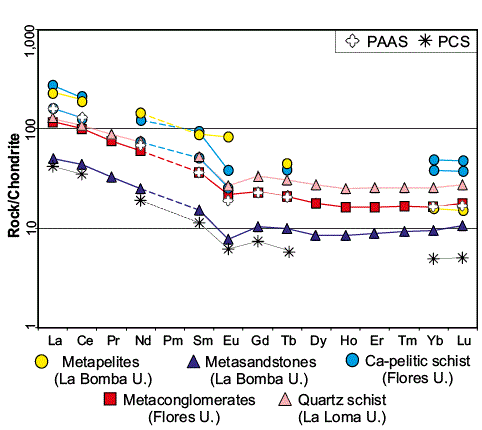
Figure 15 Chondrite-normalized (Sun and McDonough, 1989) REE diagram of samples from the Difunta Correa metasedimentary sequence.
Sr-Nd isotope composition of detrital rocks
The Sr-isotope composition of four siliciclastic samples is shown in Table 3. Siliclastic rocks yielded 87Sr/86Sr ratios recalculated to the time of sedimentation (ca. 600 Ma) between 0.71150 and 0.71930. The corresponding εSr600 values range from 107 to 218, i.e., well above Bulk Earth.
The 143Nd/144Nd600 values of the four detrital rocks range from 0.51156 to 0.51176. The εNd600 values range from -6.04 to -2.14 and Nd depleted mantle model ages (TDM) are between 1.33 and 1.64 Ga.
Phosphatic clasts
Four grains of phosphate minerals were analyzed in one phosphatic clast from metaconglomerates of the Flores unit (Table 4). The composition (weight %) is very homogenous with 1.97 to 2.47 wt % F and minor contents of FeO, MnO and Cl. They are classified as apatite-(CaF), i.e., fluor-apatite (Pasero et al., 2010). The 87Sr/86Sr ratio measured in two phosphatic clasts yielded values of 0.72163 and 0.72290 (Table 3).
DISCUSSION
Protoliths and sedimentary setting of the DCMS
Metamorphism is considered essentially an isochemical process, with restricted mobility of non-volatile elements (Fettes and Desmons, 2007; Vernon and Clarke, 2011). Hence, ratios between some major and trace elements and the REE contents in meta-detrital rocks should reflect the mineralogical composition of protoliths, sediment maturity, and possible source areas. High Field Strength (HFS) elements (e.g., La, Th, Zr, Hf, Sc and Ti) can be used to infer the source area composition and the tectonic setting because they are immobile elements, and ratios between them do not significantly change during diagenesis and metamorphism (Bhatia and Crook, 1986). Elements like Th and La are useful for identifying igneous felsic sources, whereas Zr and La concentrations reflect the degree of either crustal recycling or input from siliceous sources. Sc and Ti are related to mafic sources (Bhatia and Crook, 1986).
Source areas composition and tectonic setting were estimated here using the plots proposed by Roser and Korsch (1988; Figure 16a and 16b), Floyd and Leveridge (1987; Figure 16c) and Bhatia and Crook (1986; Figure 16d-16f). The DCMS samples suggest predominantly felsic-to-intermediate source areas with scarce influence of mafic rocks. Furthermore, most data point to continental and passive margin sedimentation (Figure 16d-16f). As it was pointed out above, these tectonic setting discrimination diagrams have to be used with caution because they often show erroneous results (Armstrong-Altrin and Verma 2005; Verdecchia and Baldo, 2010). Thus, we use here these diagrams to better constrain the tectonic setting of the basin but regional geological evidence is also considered. Marbles with sea-water Sr-isotope composition (i.e., Vallecito unit; Galindo et al., 2004), phosphatic clasts in the Flores unit and the lack of contemporaneous arc related igneous rocks further support passive margin sedimentation. A similar interpretation was proposed by Rapela et al. (2015) based on detrital zircon geochronology of the DCMS.
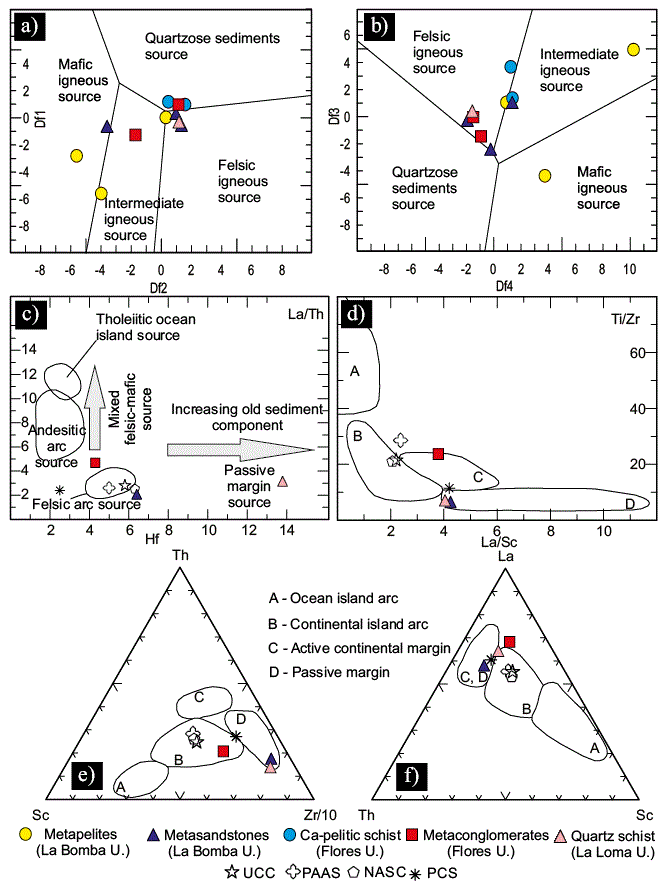
Figure 16 Source areas and tectonic setting diagrams. a) and b) Roser and Korsch, (1988). Discriminant function (Df) calculated as: Df1 = 56.500 TiO2/ Al2O3 10.879 Fe2O3/Al2O3 + 30.875 MgO/Al2O3 5.404 Na2O/ Al2O3 + 11.112 K2O/ Al2O3 3.89; Df2 = 30.638 TiO2/ Al2O3 12.541 Fe2O3/ Al2O3 + 7.329 MgO/ Al2O3 + 12.031 Na2O / Al2O3 + 35.402 K2O / Al2O3 6.382; Df3 = 0.445 TiO2+ 0.070 Al2O3 0.250 Fe2O31.142 MgO + 0.438 CaO + 1.475 Na2O + 1.426 K2O 6.861; Df4 = -1.773 TiO2+ 0.607 Al2O3 + 0.760 Fe2O31.500 MgO + 0.616 CaO + 0.509 Na2O 1.224 K2O -9.090. In all discriminant functions Fe2O3 represents total Fe content. c) Floyd and Leveridge (1987). d) f) Bhatia and Crook (1986).
Significance of Srand Nd-isotope composition of detrital rocks
As siliciclastic rocks are composed of detrital minerals and clasts, the whole-rock isotope signature may be a mixture of components coming from different sources with different isotope compositions and different ages. The variations in the 87Sr/86Sr600 ratios (0.71150-0.71930) and the εSr600 values (107-218) of the four siliciclastic samples (Table 3) can thus be attributed to a mixture of components from different sources. The high values of εSr600 suggest that the siliciclastic rocks resulted from the erosion of an evolved continental crust.
Nd-isotope composition as shown by the εNd600 values between -2.14 and -6.04 (Table 3) also suggests contribution mainly from an evolved continental source. Nd model ages (TDM) between 1.3 and 1.6 Ga further imply that the continental source was chiefly Mesoproterozoic (and probably older). Metasedimentary rocks of the Precambrian basement in the WSP (Sierra de Pie de Palo, Maz, Espinal and Umango; Figure 1a), yield Nd TDM ages between 1.2 and 2.7 Ga (Figure 17; Varela et al., 2003; Porcher et al., 2004; Casquet et al., 2008). A first group of ages (between 1.7 and 2.7 Ga) are restricted to the Maz suspect terrane in the sierras de Maz and Espinal. The latter consists of a strip of metasedimentary rocks that hosts a middle Mesoproterozoic juvenile magmatic arc and late Mesoproterozoic massif-type anorthosites with U-Pb ages between ca. 1.3 and 1.07 Ga (Casquet et al., 2005a, b; Rapela et al., 2010). On the other hand, the second group of model ages (between 1.2 and 1.6 Ga) involve a significant Nd contribution from Mesoproterozoic igneous sources and from reworking of older sedimentary and/or igneous rocks. This group corresponds not only to the DCMS of the SPP but also to metasedimentary successions with extensive marble beds in the sierras de Maz and Espinal (Casquet et al., 2008) and in the westernmost Sierra de Umango, probably equivalent to the DCMS, where a Mesoproterozoic basement has also been recognized (Varela et al., 2011). In all cases, as in the SPP, the original relationships between the second group of metasedimentary rocks and the Mesoproterozoic basement are overprinted by ductile shearing and/or faulting. However, the argument that the metasedimentary successions of the second group of Nd model ages were laid down on the Mesoproterozoic basement that outcrops in the WSP seems wellfounded as they are commonly juxtaposed. Isotope geochemistry and detrital zircon evidence (i.e. the abundance of Mesoproterozoic ages) in this second group of metasedimentary rocks (Casquet et al., 2008; Rapela et al., 2015) further strengthen this interpretation.
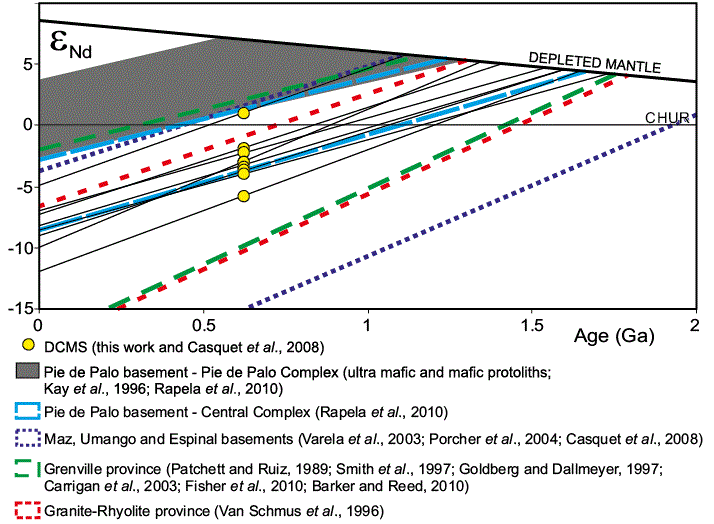
Figure 17 Comparison of isotope data of the Difunta Correa metasedimentary sequence (DCMS), with the probable source areas.
We thus infer that the main source of the DCMS was the Mesoproterozoic basement that crops out in the sierras de Maz, Espinal, Umango and in the Central Complex of SPP. This basement underlaid the DCMS at the time of sedimentation. Moreover, rocks with Nd isotope composition similar to the DCMS are also exposed in southeastern Laurentia (present position) in the Grenville and GraniteRhyolite provinces (Figures 17 and 18). These foreign sources have also been invoked -particularly the secondto explain some peculiarities of the detrial zircon patterns such as a population of grains between 1.3 and 1.5 Ga with no likely sources in the WSP Mesoproterozoic basement (Rapela et al., 2015).
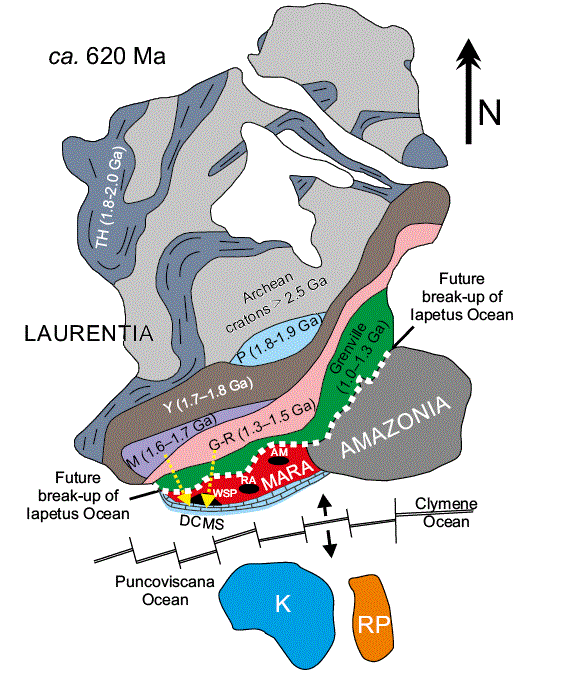
Figure 18 Paleogeographical reconstruction of Laurentia, Amazonia, Río de la Plata (RP) and Kalahari (K) showing the guessed position of MARA (acronym of Maz, Arequipa, Rio Apa) craton at ca. 620 Ma. Ages of Laurentian Precambrian orogenic belts and cratons according to Goodge et al. (2004) and Tohver et al. (2004) (Laurentia in its present position). Outcrops of basement with Mesoproterozoic ages in MARA have been included: AM, Arequipa Massif (Peru); RA, Rio Apa (Brazil, Paraguay); WSP, Western Sierras Pampeanas (Argentina). Laurentia: TH, Trans-Hudson and related mobile belts; P, Penokean orogen; Y, Yavapai orogen; M, Mazatzal orogen; G-R, Granite-Rhyolite province. Arrows show the hypothetical direction of sediment transport from the probable source areas of the Difunta Correa metasedimentary sequence (DCMS).
Phosphatic clasts in the Flores unit
The 87Sr/86Sr ratios in phosphorites (if not modified by later processes) should reflect the isotope composition of sea-water at the time of deposition (McArthur et al., 1990; Compton et al., 2002). Previous contributions (Galindo et al., 2004) found 87Sr/86Sr ratios between 0.70732 and 0.70742 in marbles of the DCMS which point to an early Ediacaran depositional age according to the Sr-isotope composition of sea-water in the middle to late Neoproterozoic (Halverson and Shields, 2011). The difference between the 87Sr/86Sr ratios of the DCMS marbles and those of phosphatic clasts (0.71991 and 0.72150 at 600 Ma) suggests that clast-forming phosphate was isotopically modified. In fact, radiogenic Sr is lost from clastic K-phyllosicates (muscovite and K-clays minerals) during heating and can be taken up by apatite (Wasserburg et al., 1964; Baadsgaard and Van Breemen, 1970), raising the 87Sr/86Sr ratios of phosphatic rocks. Moreover, the 87Sr/86Sr ratio of phosphate clasts at the age of Famatinian metamorphism (ca. 465 Ma; Casquet et al., 2001) is remarkably similar (0.72030 and 0.72182) to three of the siliciclastic samples from the DCMS (0.72009-0.72102; Table 3). Thus, phosphatic clasts probably underwent isotope exchange with the host siliciclastic matrix during metamorphism, favored by the relatively small size of the clasts and the strong compositional disequilibrium with the matrix. This exchange between phosphatic clasts and matrix can explain the outer zone (apatite rich) shown around some clasts (Figure 6a).
The phosphatic clasts were derived from the erosion of older phosphorite bodies. Phosphogenic events in the Neoproterozoic were episodic and of global extent (Cook and McElhinny, 1979; Bentor, 1980; Sheldon, 1980, 1981; Cook and Shergold, 2005; Xiao et al., 2012) and time-related with glaciations (Cook and McElhinny, 1979; Sheldon, 1980, 1981; Cook, 1992; Bertrand-Sarfati et al., 1997; Cook and Shergold, 2005). Considering that the marbles of the Vallecito unit probably formed in the early Ediacaran (ca. 600; Murra et al., 2014; Rapela et al., 2015) and that the Flores unit is stratigraphically older, we can speculate that phosphorite protoliths of the phosphatic clast probably formed near the Cryogenian-Ediacaran boundary, after the Marinoan (ca. 630 Ma) glaciation. However, unequivocal evidence for glaciogenic rocks in the lower DCMS has not been found yet.
The Neoproterozoic Sierras Bayas Group in the Tandilia System that overlies the Río de la Plata craton in southeastern Buenos Aires province, contains limestones with Sr-isotope composition similar to the DCMS marbles (Gómez Peral et al., 2007, 2014). Two phosphogenic events were recognized in the Tandilia System (Gómez Peral et al., 2014) that could thus be correlated with the protolith of the DCMS phosphatic clasts. In fact, Gaucher et al. (2008) suggested that the WSP was attached to the Río de la Plata craton in the Neoproterozoic and constituted a source area for the Sierras Bayas Group. However, detrital zircon age patterns from the Sierras Bayas Group (Rapela et al., 2007; Gaucher et al., 2008; Cingolani et al., 2010) are significantly different from those of the DCMS (Rapela et al., 2005; 2015). Although the Sierras Bayas Group contains late Mesoproterozoic zircons (between ca. 1.0 and 1.2 Ga) the dominant peaks are ca. 1.5 Ga, 2.0-2.2 Ga, 2.45 Ga and 2.7-2.8 Ga. However, the latter are absent or poorly represented in the DCMS. Therefore, detrital zircon data suggests that the source areas of the DCMS and the Sierras Bayas Group were different.
A paleogeographic scenario
Elemental and isotope geochemistry, as well as geological evidence suggest that the Ediacaran DCMS was probably deposited on a felsic to intermediate continental basement at a continental passive margin. The main source of the DCMS was probably the Mesoproterozoic basement that crops out in the sierras de Maz, Espinal, Umango and in the Central Complex of SPP. This basement underlaid the DCMS at the time of sedimentation. Furthermore, rocks with Nd isotope composition similar to the DCMS are also exposed in southeastern Laurentia (present position), in the Grenville and Granite-Rhyolite provinces (Figures 17 and 18). These Laurentian sources have also been invoked -particularly the secondto explain the detrital zircon patterns with no likely sources in the WSP Mesoproterozoic basement (Rapela et al., 2015).
The relationships between the DCMS and the mafic-ultramafic Pie de Palo Complex remain unknown because both are separated by the Duraznos thrust that underwent displacement during the Ordovician and the Silurian (Mulcahy et al., 2011) (Figure 2). Moreover, the juvenile Pie de Palo Complex and the Caucete Group probably was part of the Precordillera terrane, exotic or simply allocthonous, which reached a position close to the present in the Middle to late Ordovician (Ramos et al. 1998; Thomas and Astini, 2003; Astini and Dávila, 2004).
Our data are compatible with the idea that the WSP basement was part of the MARA continental block (Casquet et al., 2012). According to this hypothesis the southeastern passive margin of Laurentia in the Neoproterozoic was not the Appalachian margin but the eastern (present position) MARA margin, where the original sediments of the DCMS were laid down in the Puncoviscana/Clymene Ocean (Figure 18).
CONCLUSIONS
Metasedimentary rocks from the DCMS were classified as shales, Fe-shale and immature sandstones (wacke, sub-litharenite, litharenite and Fe-sandstone) based on chemical parameters. Modal variations of phyllosilicates (mainly pelitic component) and quartz-feldspar (psammitic component) are supported by negative correlations of TiO2, Al2O3, Fe2, MgO and K2O with SiO2 and positive correlations of Fe2O3, Al2O3, and K2O against TiO2, and of Al2O3 with K2O. Almost all samples exhibit a negative Eu anomaly (EuN / EuN * = 0.61-0.74), which indicates a typical continental crust composition.
At least part of the DCMS is of marine origin and the detrital sediments came from a felsic to intermediate continental source and were deposited on the continental passive margin of the MARA block in the Puncoviscana/Clymene Ocean. This source probably laid in the Mesoproterozoic basement of the WSP and in the Grenville and Granite-Rhyolite provinces of southeastern Laurentia.
The phosphatic clasts from the Flores unit probably correspond to reworking of phosphorites formed after one of the worldwide Neoproterozoic glaciations. Because the age of the lower tract of the DCMS can be constrained to be younger than ca. 630 Ma we suggest that this glaciation was the Marinoan, although glaciogenic sediments have not been firmly recognized yet in this part of the Sierras Pampeanas.











 text new page (beta)
text new page (beta)

